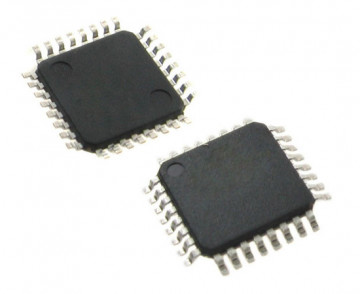ATMEGA168PB-AU
| Hersteller: | MICROCHIP |
| Architektur: | 8-bit |
| FLASH-Speicher: | 16kB |
| RAM-Speicher: | 1kB |
| EEPROM-Speicher: | 512B |
| Anzahl der Eingänge/Ausgänge: | 27 |
| Versorgungsspannungsbereich: | 1,8V~5,5V |
| Hersteller: | MICROCHIP |
| Architektur: | 8-bit |
| FLASH-Speicher: | 16kB |
| RAM-Speicher: | 1kB |
| EEPROM-Speicher: | 512B |
| Anzahl der Eingänge/Ausgänge: | 27 |
| Versorgungsspannungsbereich: | 1,8V~5,5V |
| Frequenz: | 20,000MHz |
| A/D Umwandler: | JA |
| D/A Umwandler: | NEIN |
| UART/USART schnittstelle: | JA |
| SPI schnittstelle: | JA |
| TWI (I2C) schnittstelle: | JA |
| CAN schnittstelle: | NEIN |
| ETHERNET schnittstelle: | NEIN |
| USB schnittstelle: | NEIN |
| Verschlüsselung: | NEIN |
| Betriebstemperatur (Bereich): | -40°C ~ 85°C |
| Gehäuse: | TQFP32 |
8-bit Mikrocontroller Atmel AVR® mit 16 kB Flash-Speicher und Programmiermöglichkeit im Gerät: ATmega168PB.
Eigenschaften:
• Effizienter 8-Bit Mikrocontroller Atmel® AVR® mit geringem Energieverbrauch
• Fortgeschrittene RISC-Architektur
- 131 Befehle, die umfangreiche Möglichkeiten bieten und in der Regel in einem einzigen Taktzyklus ausgeführt werden
- 32 8-Bit General-Purpose Arbeitsregister
- Völlig statische Betriebsweise
- Bis zu 20 MIPS bei 20 MHz
- Eingebauter 2-Zyklen-Multiplizierer
• Nicht-flüchtiger Speicher, der für hohe Haltbarkeit segmentiert ist
- 16 kB Flash-Speicher, der im Gerät programmiert werden kann
- 512 Bytes EEPROM
- 1024 Bytes interner SRAM
- Schreib- und Lesezyklen: Flash 10.000, EEPROM 100.000
- Schreibhaltbarkeit: 20 Jahre bei 85°C / 100 Jahre bei 25°C
- Optionale Bootloader-Sektion mit unabhängigen Lock-Bits
• Programmierung über Bootloader
• Lesen während des Schreibens unterstützt
- Programmierverhinderung zur Sicherheit
• Unterstützung der Atmel® QTouch®-Bibliotheken
- Kapazitive Touch-Buttons, Slider und Drehregler
- Unterstützung von QTouch und QMatrix
- Bis zu 64 Touch-Kanäle
• Peripherieeinheiten
- Zwei 8-Bit Timer/Counter mit getrennten Prescaler- und Vergleichsmodi
- 16-Bit Timer/Counter mit getrennten Prescaler-, Vergleichs- und Erfassungsmodi
- Echtzeituhr (RTC) mit separatem Oszillator
- Sechs PWM-Kanäle
- 8-Kanal, 10-Bit ADC mit Temperaturmessoption
- Programmierbares USART mit Frame-Start-Erkennung
- SPI Master/Slave-Schnittstelle
- Zwei-Draht-Serielle Schnittstelle (Philips I2C-kompatibel)
- Programmierbarer Watchdog mit eingebautem separatem Oszillator
- Eingebauter Analog-Komparator
- Unterbrechung und Wake-up-Fähigkeit bei Pin-Statusänderung
• 256-Kanal Kapazitives Touch-/Nähe-Erkennungssystem
• Besondere Merkmale des Mikrocontrollers
- Power-on Reset (PoR) und niedrige Spannungserkennung (BOR)
- Eingebauter kalibrierter Oszillator
- Interne und externe Unterbrechungen
- Sechs Schlafmodi: Idle, ADC Rauschunterdrückung, Energiesparmodus, Standby, Bereitschaft und Erweiterte Bereitschaft
- Einzigartige Gerätekennung
• Gehäuse und I/O-Ports
- 27 programmierbare I/O-Leitungen
- TQPF-32 und VFQFN-32 Gehäuse
• Betriebsspannung: 1.8V~5.5V
• Temperaturbereich: –40°C ~ 105°C
• Arbeitsgeschwindigkeit: 0–4 MHz bei 1.8–5.5 V; 0–10 MHz bei 2.7–5.5 V; 0–20 MHz bei 4.5–5.5 V
• Energieverbrauch bei 1.8V, 1 MHz und 25°C
- Betriebsmodus: 0,35 mA
- Idle-Modus: 0,4 μA
- Energiesparmodus: <1,0 μA (einschließlich 32 kHz RTC)
Der AVR Kern kombiniert einen umfangreichen Befehlssatz mit 32 allgemeinen Arbeitsregistern. Alle 32 Register sind direkt mit der Arithmetisch-Logischen Einheit (ALU) verbunden, sodass der Zugriff auf zwei unabhängige Register innerhalb eines einzelnen Befehls erfolgt, der in einem Taktzyklus ausgeführt wird. Diese Architektur ermöglicht die Erstellung von effizienten Programmen, die bis zu zehn Mal schneller ausgeführt werden als herkömmliche CISC-Mikrocontroller.
Der ATmega168PB Mikrocontroller bietet: 8 kB Flash-Speicher, der im Gerät programmiert werden kann; 512 Bytes EEPROM; 1024 Bytes SRAM; 23 allgemeine I/O-Leitungen; 32 allgemeine Arbeitsregister, drei flexible Timer/Counter mit Vergleichsmodi; Unterstützung für interne und externe Unterbrechungen; USART mit Programmmierbarkeit; Zwei-Draht-Schnittstelle gemäß Philips I2C-Standard; SPI-Schnittstelle; 6-Kanal, 10-Bit ADC (8-Kanal bei TQFP- und VFQFN-Gehäusen), programmierbarer Watchdog mit eingebautem Oszillator und sechs Energiesparmodi, die durch Software aktiviert werden.
Der Idle-Modus stoppt die CPU, während SRAM, Timer/Counter, USART, Zwei-Draht-Serielle Schnittstelle, SPI-Port und das Unterbrechungssystem weiterhin arbeiten. Der Power-down-Modus bewahrt den Zustand der Register, während der Oszillator und alle Funktionen des Geräts ausgeschaltet werden, bis das nächste Unterbrechen oder ein Hardware-Reset erfolgt. Im Standby-Modus arbeitet der asynchrone Timer weiter, sodass der Benutzer die Timerdaten beibehalten kann, während der Rest des Geräts in den Ruhemodus versetzt wird. Der ADC-Rauschunterdrückungsmodus stoppt die CPU und alle I/O-Module außer dem asynchronen Timer und ADC, um Rauschen während der ADC-Konvertierung zu minimieren. Der Bereitschaftsmodus lässt den Quarzoszillator/RC weiterlaufen, während der Rest des Geräts schläft. Dies ermöglicht ein schnelles Aufwecken des Geräts bei minimalem Stromverbrauch.
Atmel® bietet Unterstützung für die QTouchR-Bibliothek, die es ermöglicht, kapazitive Touch-Buttons, Slider und Drehregler in AVR® Mikrocontrollern zu nutzen. Die patentierte Signal-Ladungs-Übertragungsabtasttechnik ermöglicht eine effektive Touch-Erkennung und sorgt für Widerstandsfähigkeit gegenüber virtuellen "Kontaktschwankungen" bei Touch-Tasten. Darüber hinaus sorgt die AKS®-Technologie dafür, dass benachbarte Tasten eindeutig erkannt werden. Die QTouch Composer Software ermöglicht das Testen, Entwickeln und Debuggen von Touch-Anwendungen.
Der Chip wird mit Atmels Technologie für hochdichte nicht-flüchtige Speicher hergestellt. Der eingebaute Flash-Speicher ermöglicht das erneute Programmieren des Geräts im Gerät über die SPI-Serielle Schnittstelle. Es kann auch einen Bootloader nutzen, der auf dem AVR-Kern läuft, oder einen traditionellen Programmer für nicht-flüchtige Speicher. Der Bootloader kann jede Schnittstelle nutzen, um Anwendungen in den Flash-Speicher zu laden. Der Boot Flash-Bereich funktioniert weiter, wenn der Flash-Bereich programmiert wird.

